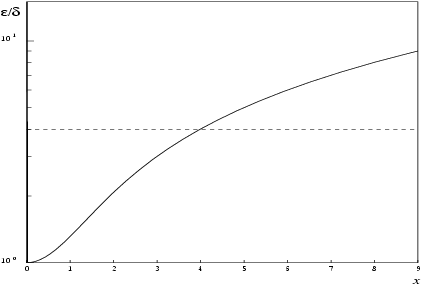NAG C Library Function Document
nag_sinh (s10abc)
1
Purpose
nag_sinh (s10abc) returns the value of the hyperbolic sine, .
2
Specification
| #include <nag.h> |
| #include <nags.h> |
| double |
nag_sinh (double x,
NagError *fail) |
|
3
Description
nag_sinh (s10abc) calculates an approximate value for the hyperbolic sine of its argument,
.
For
it uses the Chebyshev expansion
where
.
For
where
is a machine-dependent constant, details of which are given in the
Users' Note for your implementation.
For , the function fails owing to the danger of setting overflow in calculating . The result returned for such calls is , i.e., it returns the result for the nearest valid argument.
4
References
5
Arguments
- 1:
– doubleInput
-
On entry: the argument of the function.
- 2:
– NagError *Input/Output
-
The NAG error argument (see
Section 3.7 in How to Use the NAG Library and its Documentation).
6
Error Indicators and Warnings
- NE_ALLOC_FAIL
-
Dynamic memory allocation failed.
See
Section 2.3.1.2 in How to Use the NAG Library and its Documentation for further information.
- NE_INTERNAL_ERROR
-
An internal error has occurred in this function. Check the function call and any array sizes. If the call is correct then please contact
NAG for assistance.
See
Section 2.7.6 in How to Use the NAG Library and its Documentation for further information.
- NE_NO_LICENCE
-
Your licence key may have expired or may not have been installed correctly.
See
Section 2.7.5 in How to Use the NAG Library and its Documentation for further information.
- NE_REAL_ARG_GT
-
On entry, .
Constraint: .
The function has been called with an argument too large in absolute magnitude. There is a danger of overflow. The result returned is the value of at the closest argument for which a valid call could be made.
7
Accuracy
If
and
are the relative errors in the argument and result, respectively, then in principle
That is the relative error in the argument, , is amplified by a factor, approximately . The equality should hold if is greater than the machine precision ( is a result of data errors etc.) but, if is simply a result of round-off in the machine representation of , then it is possible that an extra figure may be lost in internal calculation round-off.
The behaviour of the error amplification factor can be seen in the following graph:
Figure 1
It should be noted that for
where
is the absolute error in the argument.
8
Parallelism and Performance
nag_sinh (s10abc) is not threaded in any implementation.
None.
10
Example
This example reads values of the argument from a file, evaluates the function at each value of and prints the results.
10.1
Program Text
Program Text (s10abce.c)
10.2
Program Data
Program Data (s10abce.d)
10.3
Program Results
Program Results (s10abce.r)

